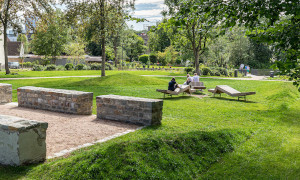Schoolyards are educational spaces. Their importance for social learning, for experiencing one's own effectiveness, for motor development and as spaces for self-directed action and learning are often still underestimated.
Movement is a potential inherent in the human being, is regarded as an essential medium for the appropriation of the world and shows itself in adolescents in the desire to move and in the joy of movement and play.
School should be designed in such a way that the pupils are supported in their joy of movement and play, in that they experience moving, exciting lessons, with plenty of room for independent activity. School should be a place for living and learning, where the spatial design alone invites pupils to try things out and experience new things.
Herrmann Städtler, "Moving School" - Healthy School Lower Saxony, Hanover
Almost all federal states have developed initiatives to bring more movement into schools. The aim is to replace rigid, highly regimented forms of learning (education) in favour of self-acting learning (training). Scientific studies prove the positive correlation between physical activity and the quality of teaching and learning. The influence of movement on well-being and thus on learning attitude and motivation seems to be particularly significant.
Schoolyard - part of a diverse, lively learning landscape
All-day schooling, inclusion, digitalisation, learning research findings, etc. - the outdoor space is becoming an important spatial resource.
The term 'green classroom', which is often used, does not go far enough or even makes the wrong statement. A 'classroom' is also no longer appropriate indoors. So it is not a question of reproducing it outdoors. Rather, it is about designing a diverse outdoor space that includes areas for appropriation, experimentation, exploration, etc., in addition to defined areas. As with the school building, the requirements for openness, diversity of use and overlapping of use also apply to the outdoor space.
Barbara Pampe, Executive Director, Montag Foundation Youth and Society, Bonn
With appropriate planning, the schoolyard can facilitate or complement numerous activities at and in the school. The need for quality outdoor spaces for all children and young people in the neighbourhood should also be taken into account outside school hours.
The articles in the 3/2020 issue of the bdla association magazine "Landschaftsarchitekten" are dedicated to schoolyards:
- Latitude: 0
- Longitude: 0


